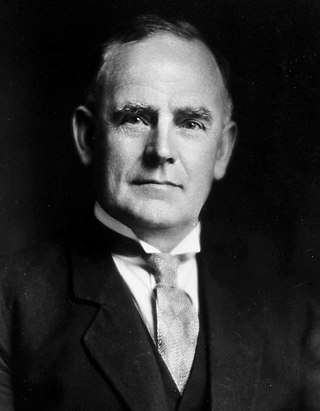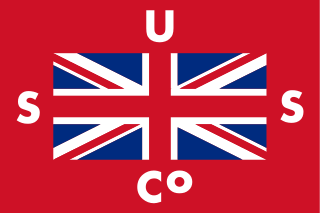The Waihi miners' strike was a major strike action in 1912 by gold miners in the New Zealand town of Waihi. It is widely regarded as the most significant industrial action in the history of New Zealand's labour movement. It resulted in one striker being killed, one of only two deaths in industrial actions in New Zealand.

Lambton Quay is the heart of the central business district of Wellington, the capital city of New Zealand.

Viaduct Harbour, formerly known as Viaduct Basin, is a former commercial harbour on the Auckland waterfront that has been turned into a development of mostly upscale apartments, office space and restaurants. It is located on the site of a formerly run-down area of the Freemans Bay / Auckland CBD waterfront in Auckland, New Zealand. As a centre of activity of the 2000 America's Cup hosted by the Royal New Zealand Yacht Squadron, as well as the 2022 Rally New Zealand, the precinct enjoyed considerable popularity with locals and foreign visitors.
The following lists events that happened during 1913 in New Zealand.
Farmers Trading Company Ltd is a New Zealand mid-market department store chain. Headquartered in Flat Bush, Auckland, Farmers operates 59 stores across New Zealand, specialising in family fashion, beauty, homewares, furniture, large appliances and whiteware.

The Stillwater Ngākawau Line (SNL), formerly the Stillwater–Westport Line (SWL) and the Ngakawau Branch, is a secondary main line, part of New Zealand's national rail network. It runs between Stillwater and Ngakawau via Westport on the West Coast of the South Island. It was one of the longest construction projects in New Zealand's history, with its first section, at the south end, opened in 1889, and the beginnings of the Ngākawau Branch, at its Westport end, in 1875. The full line was completed in 1942. The only slower railway projects were Palmerston North to Gisborne, 1872 to 1942, and the Main North Line to Picton, 1872 to 1945.

Kaiwharawhara is an urban seaside suburb of Wellington in New Zealand's North Island. It is located north of the centre of the city on the western shore of Wellington Harbour, where the Kaiwharawhara Stream reaches the sea from its headwaters in Karori. It is a largely commercial and industrial area and thus has little residential population. A recent housing development up the hillside towards Te Kainga has increased the resident population.

The First National Government of New Zealand was the government of New Zealand from 1949 to 1957 formed by the National Party. It was a conservative government best remembered for its role in the 1951 waterfront dispute. It also began the repositioning of New Zealand in the Cold War environment. Although New Zealand continued to assist Britain in situations such as the Malayan Emergency, it now became connected to Australia and the United States through the ANZUS agreement.

Seddonville is a lightly populated locality on the West Coast of New Zealand's South Island. It is most famous for the historical role it played in New Zealand's coal mining industry.

Sir William Joseph Jordan was a New Zealand Labour Party member of Parliament, and New Zealand's longest-serving high commissioner to the United Kingdom from 1936 to 1951.

Union Steam Ship Company of New Zealand Limited was once the biggest shipping line in the southern hemisphere and New Zealand's largest private-sector employer. It was incorporated by James Mills in Dunedin in 1875 with the backing of a Scottish shipbuilder, Peter Denny. Bought by shipping giant P&O around the time of World War I it was sold in 1972 to an Australasian consortium and closed at the end of the twentieth century.

Sir William Sullivan, was a New Zealand politician of the National Party. A man of large stature, he was affectionately known as "Big Bill".

The Great Strike refers to a near general strike that took place in New Zealand from October 1913 to mid-January 1914. It was the largest and most disruptive strike in New Zealand's history. At its height, it brought the economy of New Zealand almost to a halt. Between 14,000 and 16,000 workers went on strike, out of a population of just over one million.

The bridges in New Zealand are many and varied but only date back to the beginning of European settlement in the mid 19th century.

Wellington Harbour Board was the body which formerly managed the shipping and commercial affairs of the port of Wellington in New Zealand. It was constituted in 1880 and was disestablished in 1989.

The Glen Afton Branch was a branch railway line of 7.9 km in the Waikato in New Zealand, built to serve coal mines in the Awaroa district west of Huntly at Rotowaro, Pukemiro and Glen Afton. Rotowaro is Māori for "coal lake".

The Northern Steam Ship Company Ltd (NSS) served the northern half of the North Island of New Zealand from 1881 to 1974. Its headquarters, the Northern Steam Ship Company Building, remains in use on Quay Street, Auckland as a bar and is listed by Heritage New Zealand as a Category I Historic Place.
The Huntly rail bridge bombing occurred on the Glen Afton Branch, near Huntly, New Zealand around 3 a.m. on 30 April 1951, when high explosives were set off on a railway bridge. The bombing took place amid the 1951 New Zealand waterfront dispute, an industrial dispute over the working conditions and wages of dockworkers. Characterised by the-then Prime Minister Sidney Holland as an act of terrorism, the bombing caused no casualties, even though a morning passenger train ran over the weakened bridge. The perpetrators remain unknown.

Rail sabotage is the act of disrupting a rail transport network. This includes both acts designed only to hinder or delay as well as acts designed to actually destroy a train. Railway sabotage requires considerable effort, due to the design and heavy weight of railways.

















